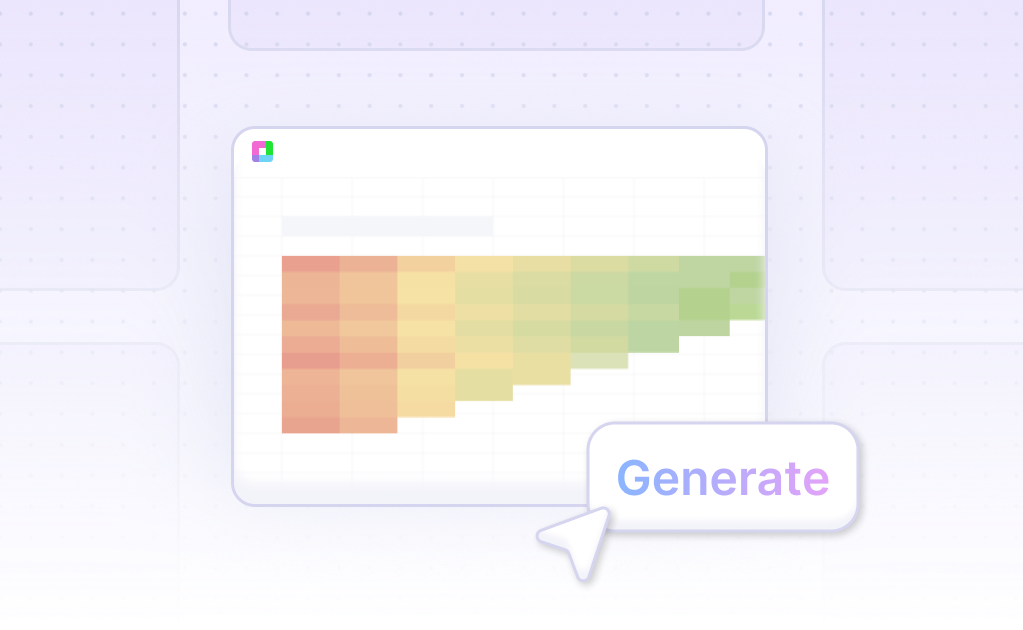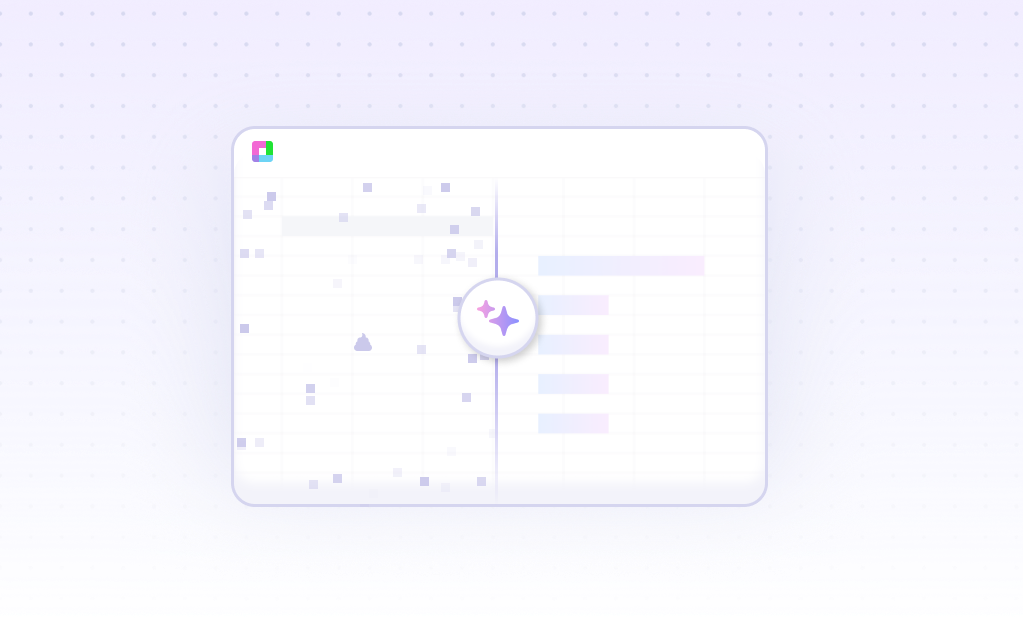
Introduction
Generating a Clustered Column - Line on Secondary Axis Chart can elevate data analysis in programs like Excel, Google Sheets, or the AI-enhanced Sourcetable. Sourcetable simplifies the process by leveraging its AI spreadsheet assistant, enabling users to rapidly create various charts and graphs. This tool is particularly useful for those new to advanced spreadsheet functions.
Sourcetable stands out by making users spreadsheet power users effortlessly. Whether you're looking to craft your chart using AI assistance or prefer the traditional spreadsheet route, our guide covers both methods comprehensively.
Sign up for Sourcetable to generate your first Clustered Column - Line on Secondary Axis Chart or continue reading for detailed guides and tips.
What is a Clustered Column - Line on Secondary Axis Chart?
Definition and Purpose
A Clustered Column - Line on Secondary Axis Chart is a combination chart that integrates two distinct types of visuals: columns and lines. This chart type utilizes a secondary axis to effectively display data series with widely varying scales or different types of data in a single visualization.
Key Features
This chart uses the primary vertical axis to represent one data series, commonly sales volumes, while the secondary vertical axis portrays another series, such as price figures. By doing so, it helps present a clear comparison between measures that have different value ranges.
Benefits
Using a Clustered Column - Line on Secondary Axis Chart allows for quicker data comparisons and correlates multiple measures within one visualization. It also optimizes canvas space by combining two charts into one, making it easier to interpret complex data.
Common Uses
This chart type is especially useful in financial data visualization, where price and volume data need to be compared. It is also effective in any scenario where mixed data types or data series with widely varying values need to be displayed together.
How to Create
To create this chart, select the data you wish to visualize, click on the INSERT tab, select the Combo button, and choose the Clustered Column - Line on Secondary Axis Chart option. Adjust the chart as needed by moving, resizing, and adding titles to enhance clarity.
When to Use a Clustered Column - Line on Secondary Axis Chart
Overview
A Clustered Column - Line on Secondary Axis Chart is best used when you need to compare multiple categories of data along with a secondary measurement. This visualization is ideal for highlighting how one or two key metrics change over time alongside other data points.
Pros of Using a Clustered Column - Line on Secondary Axis Chart
This chart type allows clear differentiation between two types of data. The clustered columns can show the primary data, while the line graph on a secondary axis can represent another variable. This dual-axis setup simplifies complex data analysis and enhances readability.
Cons of Using a Clustered Column - Line on Secondary Axis Chart
Interpreting two different scales can be challenging. This can potentially cause confusion if viewers are not familiar with the dataset. Additionally, overloading the chart with too many data series can make it cluttered, reducing its effectiveness.
Comparison with Other Charts
Compared to basic line charts, the Clustered Column - Line on Secondary Axis Chart provides a more detailed comparison across multiple categories. While line charts excel in showing trends over time, they lack the additional categorical breakdown provided by clustered columns. Conversely, standard column charts lack the trend visualization offered by the line on a secondary axis.
Conclusion
Use a Clustered Column - Line on Secondary Axis Chart when dealing with multidimensional data requiring both categorical comparison and trend analysis. Be cautious of potential clutter and scale interpretation issues. This chart effectively combines the strengths of line and column charts for more comprehensive data analysis.
How to Generate a Clustered Column - Line on Secondary Axis Chart with Sourcetable
- Sourcetable, an AI-powered spreadsheet, simplifies the creation of a Clustered Column - Line on Secondary Axis Chart. This guide outlines the straightforward steps to generate this chart using Sourcetable's AI capabilities.
- To start, <strong>create sample data</strong> using Sourcetable's AI assistant or upload a CSV. This initial step ensures that you have the data ready for visualization. Next, <strong>select the range of data</strong> you want to convert into a Clustered Column - Line on Secondary Axis Chart. This selection process helps the AI assistant understand your data's scope.
- Once your data is selected, <strong>ask the AI assistant</strong> to generate the chart. Sourcetable's AI will quickly create the Clustered Column - Line on Secondary Axis Chart based on your chosen data. Finally, you can <strong>refine or iterate</strong> on the chart by specifying changes to formatting, labels, and other elements using the AI assistant.
- Using Sourcetable AI is the most efficient method for generating a Clustered Column - Line on Secondary Axis Chart. This process contrasts with manual methods in Excel or Google Sheets, which are discussed in the next section. Sourcetable's AI offers a fast, intuitive way to create detailed and accurate visualizations.
How to Generate a Clustered Column - Line on Secondary Axis Chart in Excel and Google Sheets
Generating a Clustered Column - Line on Secondary Axis Chart in Excel
Select the data to include in the chart. Click the INSERT tab on the ribbon and then click the Combo button.
Choose the Clustered Column - Line chart option. Double-click the line for the data series and select Secondary Axis in the task pane.
Use a secondary vertical axis to make the chart easier to understand. Add axis titles by clicking the CHART ELEMENTS button, and select Primary Vertical and Secondary Vertical. Click the title boxes and type the appropriate text to label your axes.
For more detailed steps, ensure that you select the data to plot, including column headers. On the Insert tab, click Recommended Charts and in the left pane, select Combo. In the Combo setup, choose Clustered Column for one data series and Line for the other, then check the Secondary Axis box for the line data series. Complete the setup by clicking OK.
Generating a Clustered Column - Line on Secondary Axis Chart in Google Sheets
Open the Google Sheet with your data and highlight the data for the chart. Next, click on the Insert option in the main menu and select Chart from the submenu.
Change the Chart type to Column Chart, then add a line to the chart by selecting the Customize tab in the Chart Editor. Under the Customize tab, click Series and choose the data series you want to display as a line.
Assign one of your data series to a secondary axis by clicking on the three dots in the upper right corner of the chart and selecting "Edit the Chart" to open the Chart Editor. Under the Setup tab, select a chart type that supports dual axes. In the Customize tab, assign the desired data series to the secondary axis.
Make necessary adjustments to the chart to enhance readability and presentation. This ensures the chart accurately reflects the data and is easy to interpret.
Use Cases for Visualizing Data with a Clustered Column - Line on Secondary Axis Chart
Sales and Revenue Analysis |
Visualizing sales volumes alongside revenue can reveal correlations and trends. This dual-axis chart efficiently compares quantity sold (in clustered columns) to total revenue (on the line), helping identify key sales drivers and high-performing products. |
Marketing Campaign Performance |
Track marketing spend and its impact on conversion rates by mapping expenditure data on clustered columns while conversion rates are plotted on the secondary axis line. This helps assess the effectiveness of marketing strategies and optimize budget allocation. |
Product Performance Comparison |
Compare different products by plotting sales figures of each product as clustered columns and the overall market trend as a line. This visualization highlights individual product performance in relation to overall market movements. |
Financial Performance Metrics |
Display income (clustered columns) and ROI (line) simultaneously to provide a comprehensive view of financial health. This helps stakeholders visualize profitability relative to income, aiding strategic planning and investment decisions. |
Customer Segmentation Analysis |
Segment customer data and display purchase frequency (clustered columns) alongside average expenditure (line). This approach uncovers insights into customer behavior, allowing for targeted marketing and personalized offerings. |
Inventory Management |
Manage stock levels by plotting inventory data (clustered columns) and sales velocity (line). This helps in identifying overstocked or understocked items, improving stock control and reducing holding costs. |
Market Share Analysis |
Analyze market share by showcasing company sales (clustered columns) against industry sales trends (line). This comparison illustrates how the company is performing relative to the industry, guiding competitive strategies. |
Operational Efficiency Monitoring |
Monitor operational efficiency by visualizing production output (clustered columns) along with defect rates (line). This dual-axis approach helps in identifying inefficiency areas and implementing process improvements quickly. |
Frequently Asked Questions
How do I create a combo chart?
To create a combo chart, change the chart type for one or more data series to Line and set the axis of the data series to Secondary Axis. Then, set the chart type of the other data series to Clustered Column.
How do I add a secondary axis to a combo chart?
To add a secondary axis to a combo chart, change the chart type of the data series you want to plot differently to Line and set its axis to Secondary Axis.
How do I interpret data on a Clustered Column - Line Chart with a secondary axis?
Use a secondary axis to plot data series with widely varying numbers or mixed types of data. The primary vertical axis is typically for sales volume, while the secondary vertical axis is for price figures.
What are the benefits of using a Clustered Column - Line Chart with a secondary axis?
This type of chart allows you to compare multiple measures with different value ranges effectively.
What are common issues with using a secondary axis in a Clustered Column - Line Chart?
Using a secondary Y axis can be a visual distraction and cause confusion for end users. To mitigate this, set both Y axes to the same range if possible.
Conclusion
In this guide, we've covered the essentials of creating a Clustered Column - Line on Secondary Axis Chart. We delineated the process using both the powerful AI capabilities of Sourcetable and traditional spreadsheet tools like Excel and Google Sheets. Understanding how to generate such charts is crucial for data visualization and can enhance the presentation of diverse data points effectively.
Using Sourcetable's AI spreadsheet assistant simplifies complex procedures, enabling users, regardless of their experience level, to generate professional-level charts and graphs effortlessly. By integrating AI into your spreadsheet tasks, you can achieve more precise results faster.
To experience the benefits of generating a Clustered Column - Line on Secondary Axis Chart with ease, consider signing up for Sourcetable today. Start enhancing your data visualization skills at https://app.sourcetable.com/signup.
Recommended Guides
Connect your most-used data sources and tools to Sourcetable for seamless analysis.
अक्सर पूछे जाने वाले प्रश्न
यदि आपका प्रश्न यहाँ कवर नहीं किया गया है, तो आप हमारी टीम से संपर्क कर सकते हैं।
हमसे संपर्क करें




